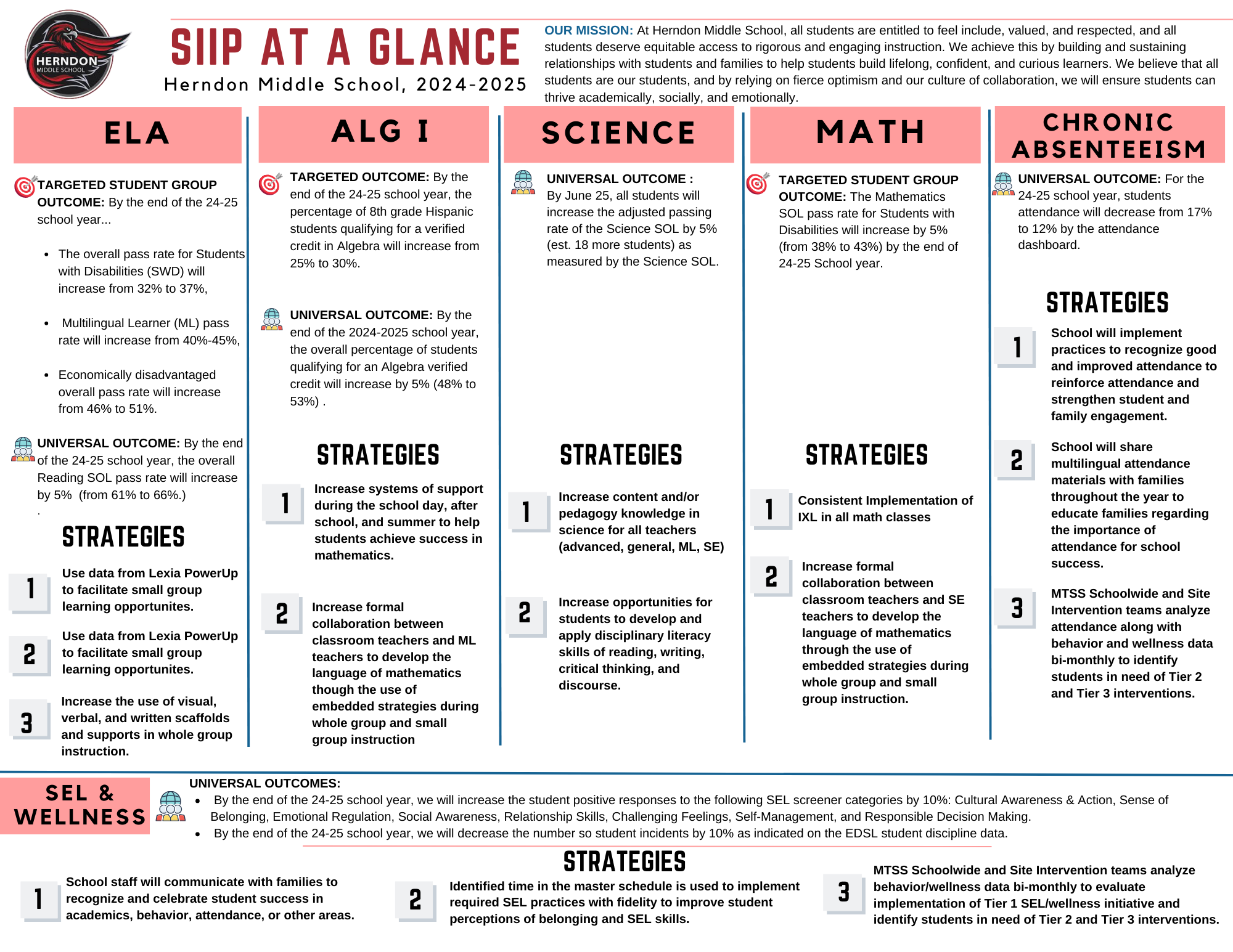School Innovation & Improvement Plan: At a Glance
2024-2025
Herndon Middle School
Region 1
Monika Vereb, Principal Herndon MS
Background: All Fairfax County school are also required to complete an access and opportunity goal as part of their School Innovation and Improvement Plan (SIIP) and can also capture additional goals.
Click here to see a PDF version

English/Language Arts:
Outcomes:
By the end of the 24-25 school year
- The overall pass rate for Students with Disabilities (SWD) will increase from 32% to 37%
- Multilingual Learner (ML) pass rate will increase from 40% to 45%
- Economically disadvantaged overall pass rate will increase from 46% to 51%
By the end of the 24-25 school year, the overall Reading SOL pass rate will increase by 5% (from 61% to 66%)
Strategies:
- Use data from Lexia PowerUp to facilitate small group learning opportunities.
- Increase the use of visual, verbal, and written scaffolds and supports in whole group instruction.
Algebra 1:
Outcomes:
By the end of the 24-25 school year
- The percentage of 8th grade Hispanic students qualifying for a verified credit in Algebra will increase from 25% to 30%.
- The overall percentage of students qualifying for an Algebra verified credit will increase by 5% (from 48% to 53%).
Strategies:
- Increase systems of support during the school day, after school, and summer to help students achieve success in mathematics.
- Increase formal collaboration between classroom teachers and ML teachers to develop the language of mathematics though the use of embedded strategies during whole group and small group instruction
Science:
Outcomes:
By the end of the 24-25 school year
- All students will increase the adjusted passing rate of the Science SOL by 5% (est. 18 more students) as measured by the Science SOL.
Strategies:
- Increase content and/or pedagogy knowledge in science for all teachers (advanced, general, ML, SWD)
- Increase opportunities for students to develop and apply disciplinary literacy skills of reading, writing, critical thinking, and discourse.
Math:
Outcomes:
By the end of the 24-25 school year
- The Mathematics SOL pass rate for Students with Disabilities will increase by 5% (from 38% to 43%) by the end of 24-25 School year.
Strategies:
- Consistent Implementation of IXL in all math classes
- Increase formal collaboration between classroom teachers and SWD teachers to develop the language of mathematics through the use of embedded strategies during whole group and small group instruction.
Chronic Absenteeism:
Outcomes:
By the end of the 24-25 school year
- students attendance will decrease from 17% to 12% by the attendance dashboard.
Strategies:
- School will implement practices to recognize good and improved attendance to reinforce attendance and strengthen student and family engagement.
- School will share multilingual attendance materials with families throughout the year to educate families regarding the importance of attendance for school success.
- MTSS Schoolwide and Site Intervention teams analyze attendance along with behavior and wellness data bi-monthly to identify students in need of Tier 2 and Tier 3 interventions.
SEL & Wellness:
Outcomes:
By the end of the 24-25 school year
- We will increase the student positive responses to the following SEL screener categories by 10%: Cultural Awareness & Action, Sense of Belonging, Emotional Regulation, Social Awareness, Relationship Skills, Challenging Feelings, Self-Management, and Responsible Decision Making.
- We will decrease the number so student incidents by 10% as indicated on the EDSL student discipline data.
Strategies:
- School staff will communicate with families to recognize and celebrate student success in academics, behavior, attendance, or other areas.
- Identified time in the master schedule is used to implement required SEL practices with fidelity to improve student perceptions of belonging and SEL skills.
- MTSS Schoolwide and Site Intervention teams analyze behavior/wellness data bi-monthly to evaluate implementation of Tier 1 SEL/wellness initiative and identify students in need of Tier 2 and Tier 3 interventions.

